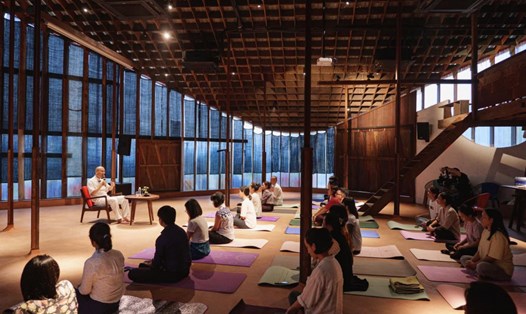One morning of the week, amid the bustling car horns in Baltimore, USA, Catherine Volcy calmly sipped a cup of hot coffee, watching the people rushing through the windows. She was a part of that rotation - waking up at 5am, quickly running out onto the street, so busy that she forgot her lunch. But then, panics come, making her realize what she is trading for. If I had just lived in such a hurry, would I really be alive? she told CNN.
Not only Catherine Volcy or in Western countries, the slow-growing trend is spreading globally. On the social network Xiaohongshu (China), many young people share about making tea stews slowly and relaxingly by hand, using a traditional small charcoal stove instead of pressing a super-fast electric button. A young girl expressed to Jing Daily that every time she leisurely sat next to the coal stove, she felt like she was lost in another peaceful world - where she could put aside all deadlines and temporarily forget the pressures of work to listen to the roaring water, enjoy the aroma of tea from the small earthen warmth.
Or in Tokyo (Japan), Sloth Club (Laughter) initiated "star-catching" nights, when millions of city residents together turned off the lights, lit candles and watched the night sky as a way to temporarily stop the busy cycle, find relaxation in the heart of the city.
A new life in the midst of urban rotation
It is not by chance that lifestyle slows down to become attractive. An Ipsos survey in 2023 shows that up to 73% of people in the world and 74% in the Asia-Pacific region want to slow down. This is no longer a single trend but has become a common desire, an Implied protest to the "hustle culture" that has been praised. Even in cities that are famous for their fast-paced lifestyle like New York or Tokyo, people are starting to find ways to "brake the wheel", creating space to breathe.
In addition, according to a report by Deloitte in 2023, 70% of Gen Z young people in the Philippines are suffering from burnout syndrome due to overwork. The scene of employees sleeping on the train and working all night is no longer strange in Tokyo, Seoul or Manila. The pressure of always having to race against time, taking advantage of every minute and every second to meet deadlines has caused many people to have no time to rest properly.
Guardian journalist Jess cartner- Morley admitted that she felt uneasy when slowing down on the streets of London, as if she was doing something wrong. The fear of being left behind makes many people run without knowing where they are running.
If in the past, slow living was considered a manifestation of stagnation and laziness, today, scientific research has proven the opposite. Living slowly does not mean giving up but is a way for people to maintain sustainability in life and work. Stephanie ODea, author of many books on slow living, emphasized on CNN: Living slowly is not falling behind or giving up ambition. On the contrary, it helps us understand the true value and know how to appreciate the smallest things.
A study by Harvard University (USA) shows that when people reduce tasks and instead spend time for purposeful rest, creativity can increase by 45%. Professor of neurology Daniel Levitin explains: The press needs breaks to reorganize information and stimulate creative thinking. When you allow yourself to have moments of separation, that is when the best ideas are formed.
In addition to increasing creativity, being slow also has a positive impact on work performance. An experiment in Iceland, where the government and businesses applied a 4-day workweek, showed that 86% of employees felt happier, significantly reduced stress, while productivity not only did not decrease but also increased.
Urban areas are experimenting with low living
Many cities around the world are looking for ways to slow down the rapid pace of life with planning policies and improving the living environment. The concept of Slow City (Cittaslow) was born in Italy in 1999 and has now spread to nearly 300 cities in 33 countries, encouraging pollution reduction, optimizing traffic and enhancing green space.
In Spain, Barcelona takes the lead with a 15-minute city model - where residents can access all the necessary amenities within walking or cycling distances. This not only reduces traffic congestion but also helps people have more time to enjoy life. The French capital Paris has also promoted pedestrian-only areas and expanded park areas. According to the Guardian, the number of cyclists in Paris has doubled in a decade, while pollution has fallen significantly.
In Asia, where cities such as Tokyo, Seoul, Singapore are famous for their fast pace of life, slow living trends are also starting to be absorbed into planning policies. Singapore pioneers in altitude gardens, turning roofs into green spaces, helping to reduce stress for urban residents. According to Urban Redevelopment Authority, the average area of trees per capita in Singapore has increased by more than 15% over a decade.
Seoul is turning streets into smart walking streets, integrating seats, air filtration systems and public spaces to encourage people to relax in the spirit of urban life. Meanwhile, some companies in Tokyo are testing a 4-day workweek policy and limiting overtime email to improve employees' mental health. A study by Japan Productivity Center shows that companies applying this model increase work performance by 10 - 15%, while significantly reducing the rate of burnout.
A gentle prediction for the future
Will a slow lifestyle really become a sustainable trend in the future, or just a wild dream? Experts say that this depends on the change in thinking of each individual and urban policies.
William Powers, author of the book "New Slow City", once experimented with slow living in New York by reducing living space, reducing working hours, and spending time connecting with the community. I used to think that if I lived slowly, I would fall behind. But no, I feel happier, work better and be more successful, he shared on Fortune.
We are living in an era where the quality of life is being balanced with the speed of economic development. As more and more people realize that running faster does not mean living better, perhaps the future of urban areas will no longer revolve around skyscrapers and rushed people. How about you? Are you willing to try living a little slower, to listen to your own beat in the busy city?









